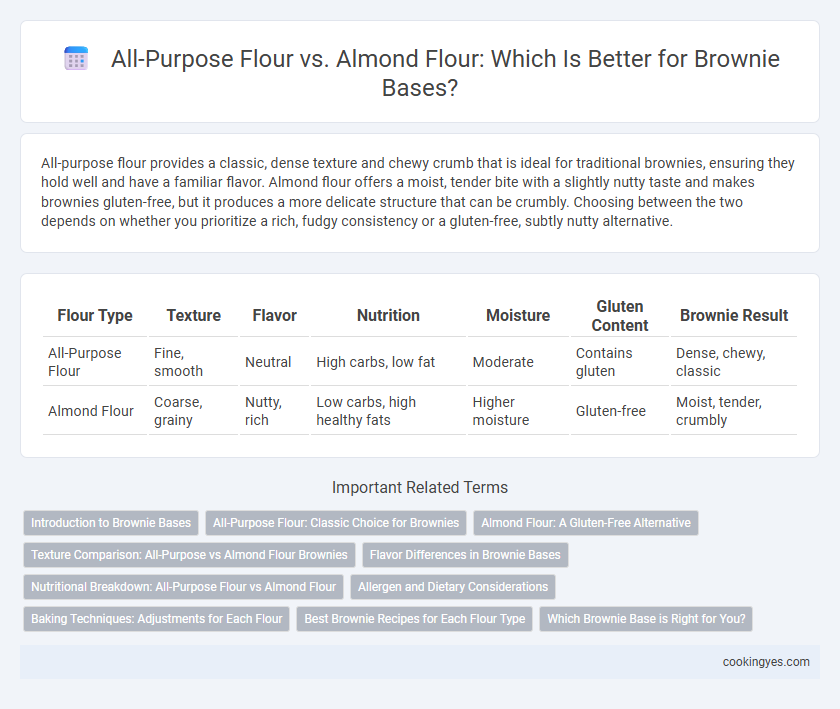All-purpose flour provides a classic, dense texture and chewy crumb that is ideal for traditional brownies, ensuring they hold well and have a familiar flavor. Almond flour offers a moist, tender bite with a slightly nutty taste and makes brownies gluten-free, but it produces a more delicate structure that can be crumbly. Choosing between the two depends on whether you prioritize a rich, fudgy consistency or a gluten-free, subtly nutty alternative.
Table of Comparison
| Flour Type | Texture | Flavor | Nutrition | Moisture | Gluten Content | Brownie Result |
|---|---|---|---|---|---|---|
| All-Purpose Flour | Fine, smooth | Neutral | High carbs, low fat | Moderate | Contains gluten | Dense, chewy, classic |
| Almond Flour | Coarse, grainy | Nutty, rich | Low carbs, high healthy fats | Higher moisture | Gluten-free | Moist, tender, crumbly |
Introduction to Brownie Bases
All-purpose flour creates a classic, dense, and chewy brownie base with a balanced texture ideal for traditional recipes. Almond flour, being gluten-free, produces a moist, tender crumb and adds a subtle nutty flavor while boosting protein and healthy fats. Choosing between these flours affects brownie density, moisture, and overall flavor profile, tailoring the treat to dietary preferences and desired texture.
All-Purpose Flour: Classic Choice for Brownies
All-purpose flour serves as the classic choice for brownie bases due to its balanced protein content, which provides the ideal structure and chewiness that brownies are known for. This flour type creates a perfect balance between cakey and fudgy textures, making it versatile for various brownie recipes. Using all-purpose flour ensures consistent results, retaining the traditional dense and moist characteristics of classic brownies.
Almond Flour: A Gluten-Free Alternative
Almond flour is a gluten-free alternative ideal for brownie bases, offering a moist and dense texture while enhancing flavor with a slightly nutty taste. Unlike all-purpose flour, almond flour is naturally grain-free and rich in healthy fats and protein, making brownies more nutritious. Its lower carbohydrate content suits gluten-sensitive individuals or those following a low-carb diet without compromising the classic brownie indulgence.
Texture Comparison: All-Purpose vs Almond Flour Brownies
All-purpose flour brownies offer a classic dense and chewy texture with a slight crisp edge, providing a traditional brownie experience. Almond flour brownies yield a moist, tender crumb with a slightly grainy texture due to the nut content, resulting in a richer, more delicate bite. The choice between these flours directly impacts the mouthfeel, where all-purpose flour produces structure and chewiness, while almond flour emphasizes softness and subtle nuttiness.
Flavor Differences in Brownie Bases
All-purpose flour offers a classic, neutral flavor that allows the rich chocolate taste of brownies to shine, creating a familiar and comforting texture. Almond flour introduces a subtle nutty sweetness and a moist, tender crumb, enhancing the depth of flavor while adding a slightly grainy texture. Choosing between these flours affects both taste and mouthfeel, with almond flour providing a distinct, more complex flavor profile compared to the straightforward backdrop of all-purpose flour.
Nutritional Breakdown: All-Purpose Flour vs Almond Flour
All-purpose flour contains approximately 455 calories, 95 grams of carbohydrates, and 13 grams of protein per 100 grams, whereas almond flour offers around 570 calories, 22 grams of carbohydrates, and 21 grams of protein. Almond flour provides higher healthy fats, primarily monounsaturated fats, contributing to better satiety and heart health benefits. The lower carbohydrate content and increased fiber in almond flour support blood sugar regulation compared to all-purpose flour in brownie recipes.
Allergen and Dietary Considerations
All-purpose flour contains gluten, which can trigger allergies or sensitivities in individuals with celiac disease or gluten intolerance, while almond flour is naturally gluten-free and suitable for these dietary restrictions. Almond flour provides a grain-free, low-carb alternative, making it ideal for paleo and keto diets but may pose a risk for those with nut allergies. Choosing between all-purpose flour and almond flour for brownies depends on allergen concerns and specific nutritional goals, ensuring safe and suitable options for diverse dietary needs.
Baking Techniques: Adjustments for Each Flour
Baking brownies with all-purpose flour requires precise flour measurement to maintain the classic fudgy texture, while almond flour demands adjustments in liquid content due to its higher fat and moisture levels. Almond flour's coarse texture necessitates a gentle folding technique to avoid overmixing, preserving the brownie's tender crumb. Temperature control is crucial; almond flour brownies benefit from slightly lower baking temperatures to prevent excessive browning and dryness caused by their nutty composition.
Best Brownie Recipes for Each Flour Type
All-purpose flour creates classic brownies with a dense, fudgy texture and a balanced crumb, ideal for traditional recipes like chewy chocolate brownies or blondies. Almond flour yields moist, gluten-free brownies with a rich, nutty flavor and tender crumb, perfect for recipes emphasizing natural sweetness and enhanced moisture retention. Selecting the appropriate flour type depends on dietary needs and desired texture, influencing recipe adjustments in baking time and ingredient ratios for optimal brownie results.
Which Brownie Base is Right for You?
All-purpose flour provides a classic brownie base with a chewy texture and balanced sweetness, ideal for those seeking a traditional dessert experience. Almond flour offers a gluten-free alternative with a moist, nutty flavor and a denser crumb, perfect for individuals with dietary restrictions or a preference for richer taste. Choosing between the two depends on dietary needs, flavor preferences, and desired brownie texture.
All-Purpose Flour vs Almond Flour for Brownie Base Infographic

 cookingyes.com
cookingyes.com